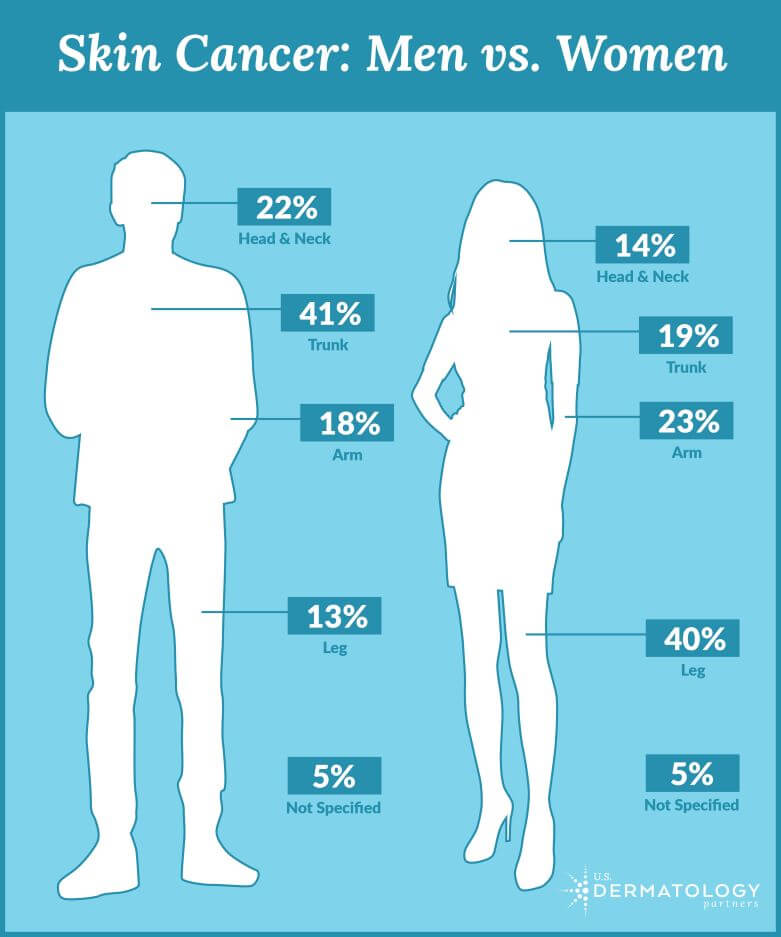Skin cancer can impact men and women. However, studies show that men may be more likely to develop all forms of skin cancer, including melanoma, squamous cell carcinoma, and basal cell carcinoma. According to Dr. Harleen Arora of U.S. Dermatology Partners in Lakewood and Denver, Colorado, “When it comes to skin cancer, I have good news and bad news. The good news is that these conditions are usually treatable when diagnosed in the early stages. The bad news is men are less likely than women to regularly examine their skin for signs of skin cancer, which means they are less likely to receive an early diagnosis. That’s just one of the many differences when it comes to how skin cancer impacts men and women.” If you’re concerned about your skin cancer risks, Dr. Arora will talk through the ways skin cancer impacts men and women and provide tips for prevention.
Why Do Men Get Skin Cancer More Than Women?
Men are significantly more likely to develop all forms of skin cancer. In fact, more than half of all people diagnosed with skin cancer are male. There are numerous reasons for this, including:
- Greater amounts of cumulative sun exposure – Men often spend more time outdoors than women for work and leisure activities, meaning their skin is exposed to a greater amount of sunlight over their lifetime. The effects of sun exposure are cumulative, meaning increased time spent in the sun can lead to a greater risk for skin cancer.
- Less likely to use sunscreen – Men are significantly less likely to apply sunscreen regularly, which increases their risk for sunburns in the short term and skin cancer in the long term. Having even one severe sunburn dramatically increases your risk of developing skin cancer.
- Infrequent skin examinations – Men visit doctors less often than women, and dermatology visits are no exception. Men are less likely to receive professional skin exams regularly unless they notice something concerning. Additionally, they are much less likely to perform regular self-checks for skin irregularities.
- Difference in skin composition – Compared to women, men’s skin is thicker with less fatty tissue and more collagen and elastin. This means that men’s skin stays firmer longer. Research has indicated that this composition can leave men more susceptible to UV damage from sunlight penetrating into deeper layers of the skin. Similar research showed that women’s skin might be better at repairing UV damage.
- Cancer locations – The leading location of skin cancer in men is the back of the neck. This area is extremely difficult to see, making men less likely to notice skin cancer right away. Additionally, men often develop skin cancers on the scalp, soles of feet, and in nail beds, all of which are difficult-to-see areas.
What Types of Skin Cancer Are Women More at Risk For?
While men are at greater risk for all types of skin cancer, including melanoma, research indicates that women aged 40 and younger may be more likely to develop skin cancer whereas men are most often diagnosed with skin cancer after age 50. According to Dr. Arora, “Women are more likely to take care of their skin in general and they are much more likely than men to apply sunscreen regularly. This reduces the risk of developing skin cancer. However, there are a few reasons why women tend to develop skin cancer at younger ages. The main one is that women are more likely to expose themselves to UV rays by tanning outdoors or in tanning beds. This additional sunlight exposure increases risk. We truly do not recommend tanning of any kind. There is no such thing as a skin-safe tan. Additionally, women are more likely to go to the doctor than men, especially when they are younger. This means women are more likely to be diagnosed at a younger age.”
Do Men and Women Get Skin Cancer in Different Spots?

Where are men and women most likely to get skin cancer?
While anyone can develop skin cancer on any part of the body, research does show that skin cancers tend to develop in the areas that receive the greatest amount of sun exposure. Dr. Arora explains, “For women, we most often see skin cancer developing on the legs and arms, which is where more than 60% of women develop skin cancer. On the other hand, men are more likely to develop skin cancer on the head, neck, and trunk. Again, these cases make up about 60% of reported skin cancer in men. If you think about this logically based on the historically typical dress for men and women, this makes sense. Women are more likely to have their arms and legs exposed when outdoors; whereas men may not typically have long hair to protect their heads and necks, and they are more likely to be shirtless outdoors.”
Skin Cancer Prevention Tips for Men & Women
According to Dr. Arora, “Early diagnosis is essential to ensure effective skin cancer treatment is available. To receive an early diagnosis, you need to perform regular self-checks, note any changes in your skin’s appearance or textures, and report them to a dermatologist as soon as possible. It’s also beneficial to have your skin professionally examined at least once each year. While having your skin checked won’t prevent skin cancer, it’s the best way to receive an early, accurate diagnosis and prevent skin cancer from spreading.” In addition to regular self-checks, keep the following recommendations in mind to reduce the risk of developing skin cancer:
- Learn the ABCDEs of skin cancer – When examining your skin, look at all moles and lesions for signs of Asymmetry, uneven Borders, irregular Color, Diameter larger than a number two pencil, and rapid Evolution.
- Wear sunscreen daily – Wearing sunscreen every day reduces the risk of skin cancer. If you’re going to be outdoors for an extended period, reapply at least every two hours or more often when swimming or sweating. A great option for daily sunscreen application is the Colorescience Sunforgettable Total Protection Face Shield Flex SPF 50. This sunscreen protects against both UVA and UVB rays, blue light, pollution, and infrared radiation. It’s safe for all skin types and skin tones.
- Choose the right sunscreen – Select a broad-spectrum sunscreen. These products protect against both UVA and UVB rays. You should also pick a product that has a sun protection factor (SPF) of 30 or higher.
- Apply sunscreen thoroughly – Make sure to use an adequate amount of sunscreen to fully cover the skin. Usually, one ounce (about the amount in a standard shot glass) of sunscreen can cover the entire body adequately. When in doubt, apply more.
- Avoid excess sun exposure – Limit time in the sun, especially between 10 am and 2 pm, when sunlight is most intense. You should also skip tanning sessions in natural light or tanning beds.
- Wear protective clothing – Wear hats, sunglasses, long sleeves, and pants when you’re going to be outdoors for long periods.
- Take sun breaks – When you’re outdoors for a prolonged period, take breaks by seeking shade or going indoors periodically.
Want to Learn More or Schedule an Annual Skin Cancer Screening?
Whether you’re worried a new spot may be skin cancer, it’s time for your annual skin exam, or you’re looking to improve your skincare routine to prevent skin cancer, we hope you’ll consider working with one of the trusted local dermatology offices of U.S. Dermatology Partners. We make it quick and easy to get started. Just take a few moments to complete our scheduling request form. Once we receive the request, a member of our local team will be in touch to finalize the details of your visit.
Find a location near me
or


